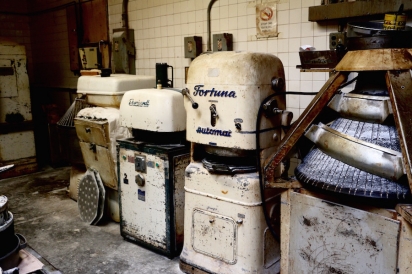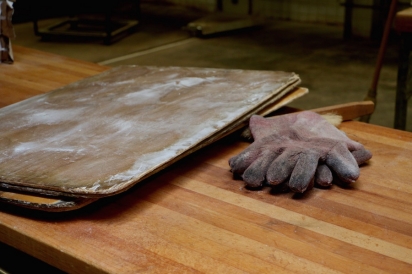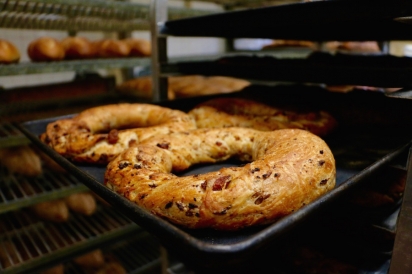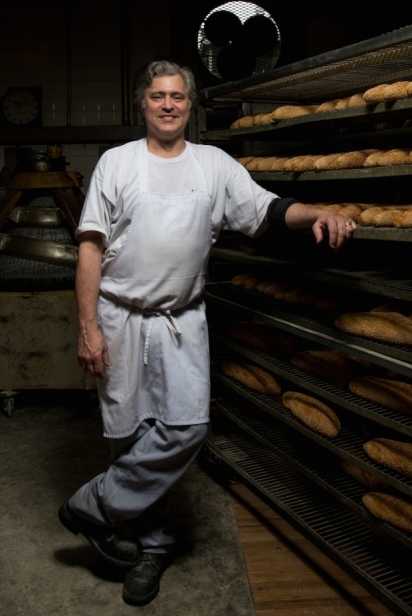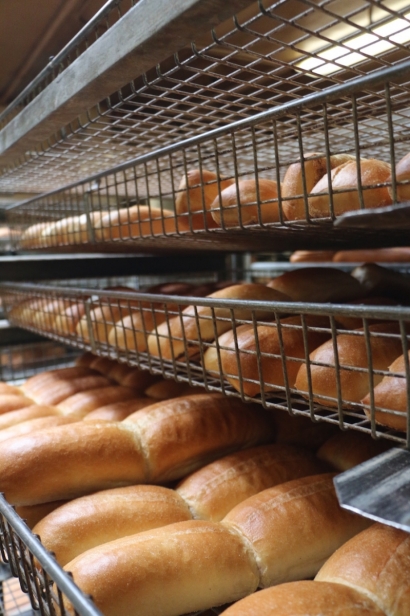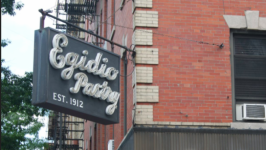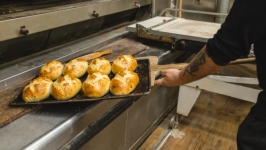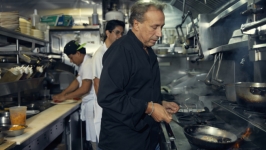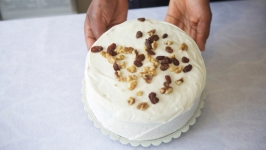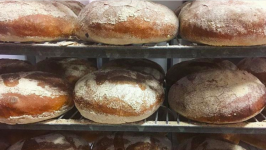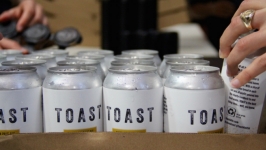There’s Magic Baked into the Walls at Addeos Family Bakery
It's a little after 11 a.m. when Laurence and Tommy Addeo are able to take a break and chat. The cousins, both in white aprons, have a subtle flour-dusted look. Maybe it’s from the long morning's work, or maybe, as the third generation of Addeos to make bread in this exact location, it’s a look that’s baked in.
We spoke in their makeshift office adjacent the front counter and storefront display cases at their bakery on Hughes Avenue—the same room that was once their grandmother's kitchen. There's a lingering scent of olives, which were pitted in the sink moments before and destined for olive bread. Bakery staff bustled by with carts of fresh whole-wheat biscuits.
Laurence and Tommy's grandparents first opened their bakery in East Harlem in the late 1920s and settled in the Bronx at the corner of Hughes Avenue and 186th Street in 1944. The building just off Arthur Avenue has been the center of the Addeo world ever since.
“There are two apartments upstairs and at one time, they only lived in one of the apartments. So, it was five children and two adults in basically what was a one-and-a-half-bedroom apartment; and they rented the other one because you gotta make ends meet,” Laurence said. “My father and my uncle shared one bed their whole lives together. And my aunts—three aunts—shared another bed. And they weren't big beds. Maybe, maybe twin bed, definitely not a full size.”
They eventually took over both apartments, a monumental expansion for a family eager to honor tradition and stick with what works. This isn't so much a fear of the unknown as it is about not fixing something that isn't broken. The Arthur Avenue area is one of the last places in the city—maybe in the whole country—where mom 'n pop shops like this can still exist. Sure, the big chain supermarkets sell bread, but it's worlds away from what the Addeo family makes. And their third-generation customer base knows it.
“I know our recipe. I know the percentage of flour, percentage of yeast, percentage of fat, percentage of everything else. But, if I had to do it somewhere else, I don't know if I could do it. I know what we do. My cousin, we all know what we do,” said Laurence. “That's where everybody fails. They fail because they don't take the time to bake.”
The Addeos could expand, and even franchise, they said. But changing any part of their product or procedures is anathema to what they do. When a big company buys a successful smaller company, the smaller company’s originators lose control and, in a way, become mascots. Col. Sanders and Chef Boyardee were real people whose products were bought by investors looking to sacrifice quality for greater profit. The cousins have clearly talked about it at length and comment rapid-fire on the subject:
“No,” said Laurence, “One thing growth does is it changes things. You take shortcuts. If you go to a big supermarket the bread may look good, but there's no way they put the same amount of time into making it.”
Tommy interjects: “They can't. The big bakeries are a production shop that's pushing out thousands of more loaves than we are, so they put starters and steam boxes because the bread has to be out by a certain time. We have the luxury, 'Oh, it's not ready? We'll wait.'”
Laurence: “We'll actually tell customers, 'I'm sorry, we can't get you the bread at that time. It's not ready.'”
Tommy: “The big production shops, they can't do that. The one thing that we did do, we put in new ovens 14 years ago.”
Beyond the capital expenditure, this issue of the new ovens might seem minor, but it yanked at the very soul of the Addeo world. The original coal-fired ovens were pulled out in the 1950s, replaced by electric ovens. Replacing these half-century-old relics with vastly more efficient ovens saved the bakery nearly 50 percent of its oil costs. In their business, a few cents here and there each day goes a long way—but Laurence and Tommy's fathers fretted endlessly about the consistency of temperature and humidity in the new ovens. Everyone was relieved when the older generation conceded that the bread remained the same. Bigger bakeries – the non-competition competition – eventually followed suit, Laurence said.
“But I don't talk about what other people do. I almost don't care what other people do. That's not what we do,” Laurence said. “It's not that you can't learn from somebody else, but it's not even remotely what we do. We know what we do.”
“My uncle once said—when people started referring to certain bread as 'artisanal'—he said, 'If I knew I made artisanal bread I would have made a lot more money,'” Laurence said. “We don't see it that way. This is a family business. We make bread.”
Tommy half-jokes that the secret ingredient to what they make is baked in the walls, that the location itself adds something not replicable.
“It's like the old pot you make the sauce in. Buy a new pot and the sauce never tastes the same,” Tommy said. “You give the recipe to someone else and go to their house and it's not the same.”
The Addeos have purchased ingredients from the same supply chain for longer than most of us have been alive. They still handpick which sesame seeds to use, sending back any that look too dark or taste wrong, even if the replacement costs more.
There's the sentimentality of taste behind Addeo & Sons Bakery, as well as the real science of baking. Just as artists instinctively know how to mix their paint or clay differently in summer or winter temperatures, master bakers know their bakery, know their ingredients and sense where adjustments need to be made.
One Addeo baker has been creating bread here for 51 years. He's 85 years old. Officially retired for more than two decades, he still comes in every Friday morning and inspects the dough mixed the night before, Laurence said.
“He comes in, the first thing he does, lifts up the boards on top of the fermentation bins and grabs the dough, feels it, looks at it, and sees where it’s at. And if it's in a certain way, he might go grab some flour and squeeze some in his hand, see how it clumps together to see how much moisture is in there or how dry it is. He can tell whether it needs more hydration or whether the flour is old or young. And those are things you can tell by touching things.”
It's part artistry, part chemistry, and part magic making.
Customer demographics have changed with the neighborhood. Fewer Italians, more Albanians, Central and South Americans, and everyone else. The heart of the business spans ethnicity, they say. The heart of the business is in fresh bread baked daily. Many of these American immigrants come from places where it's still the norm to go to the baker each day, go to the butcher or fish shop, the cheesemonger and vegetable stand. It's supporting the community by creating community.
In the 21st century New York City, success is measured in staying open for a few years, Laurence said. “We've had our business for three generations! They always talk about these new places opening up and I say, 'Yeah? Try running a business in one place, in one neighborhood for 50, 60, 70, 80 years.'”
Addeo & Sons Bakery
2372 Hughes Ave, Bronx
2352 Arthur Ave, Bronx, NY



